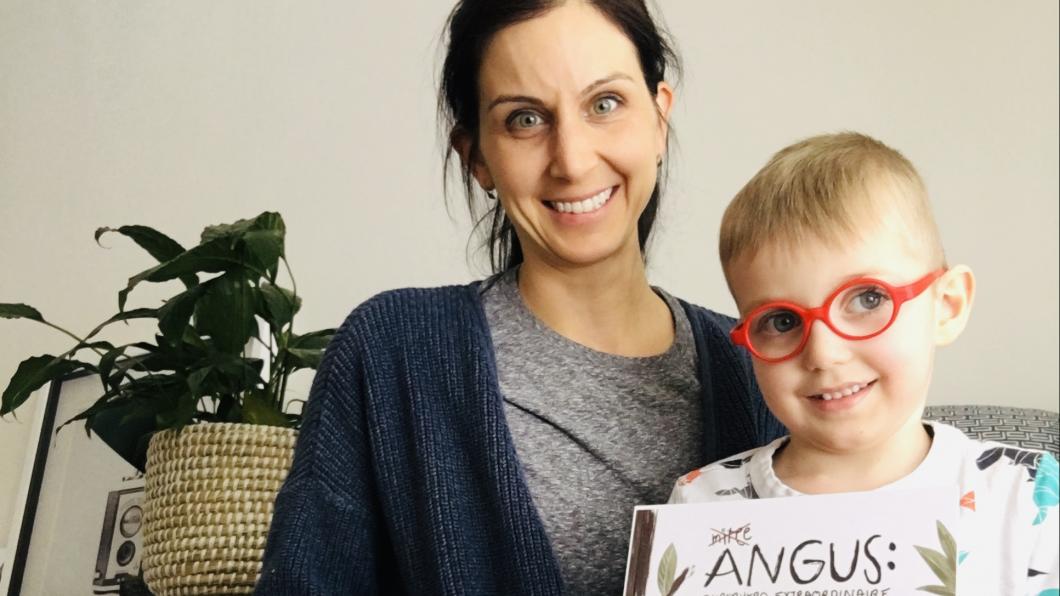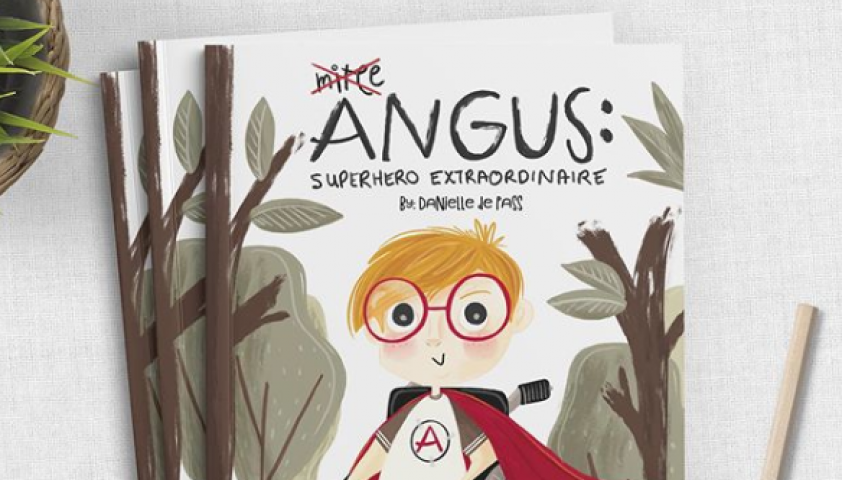
Including disability in the picture: one book at a time
When Danielle de Pass was looking for books for her kids with protagonists with disabilities, she could barely find any.
In Canada, 22% of the population lives with a disability, but when it comes to children’s books, characters with disabilities only accounted for 2%.
So Danielle decided to change that with Angus.
In her adorable children’s book, Angus: Superhero Extraordinaire, readers meet Angus—a five-year-old with a big secret: he’s a superhero! Readers get to follow along on Angus’ adventures as he sets off to save the day.
We got a chance to chat with Danielle about her inspiration, the importance of representation, and her favourite part to write.
So we wanted to start off by asking how you’re connected to the Holland Bloorview community.
We began our relationship with Holland Bloorview four and a half years ago, when my son Freddie was just 18 months old (he is now five and a half). Freddie received his first diagnosis of cerebral palsy at Bloorveiw, and subsequently came to the hospital for regular appointments with his developmental pediatrician, received botox injection therapy through the hypertonia clinic, was measured and fitted for AFOs with the orthotics team, and had weekly physiotherapy sessions with his therapists. He also attended the Bloorview Nursery School for two years.
When Freddie was three-and-a-half, we decided to move our family to London, Ontario. Freddie was receiving services at the local children's hospital in London, but was referred back to Holland Bloorview for their Selective Dorsal Rhizotomy program. In the meantime, Freddie had received another diagnosis through genetic testing: a mutation of the FAR 1 480 gene, which explained his cerebral palsy-like symptoms. Freddie underwent SDR surgery at SickKids on September 27th, 2019, and he was the first person in the world—as far as we know—with this genetic condition to receive the SDR surgery.
Freddie then stayed at Holland Bloorview as an inpatient for three months of rehabilitation. He had daily physiotherapy and occupational therapy sessions, attended the Bloorview School, and participated in the many therapeutic recreation programs that the hospital has to offer. Among his favourite things at Bloorview were playing in the therapeutic playroom, pet visiting night, and when tacos were served for lunch.
Holland Bloorview has been an integral part of our lives since Freddie was a baby; he, and our family, have been forever changed by the people we've met there. Freddie, quite literally, would not be where he is today without them.

And what inspired you to write Angus: Superhero Extraordinaire?
My kids are the inspiration behind this book. As a writer, teacher, and mother, I began to realize that the books I was reading with my children each day (as wonderful and imaginative and beautiful as they are) did not reflect my son’s reality as a disabled child, nor did they reflect my other children’s reality as siblings of a brother with a disability. I was finding it difficult to find many examples of disabled protagonists and heroes in children’s picture books to share with my children – while our bookshelves were filled with books, almost none of the characters had a wheelchair like him, or used a walker, or had to wear braces on his legs. So I decided to write one myself.
I think that when we fail to represent children with disabilities in picture books, we negate their lived childhood experiences in favor of non-disabled ones. I wanted to give a story to my son, and I came up with Angus.
How did you come up with the name Angus?
I came up with the idea for the story one night while driving home from Toronto to London, after a day of appointments with Freddie. The rest of my family had all fallen asleep in the van, and I worked out the plot and details on the two-hour drive.
It was during that drive that I began to think of names, and the names that kept resurfacing were names that my husband and I had considered for our own kids. Angus, as well as his brother Milo and sister Clementine, were names that we had briefly thought of when our children were born, and I liked the quirkiness of those names for the precocious characters in the book.
What was your favourite part to write?
I think my favourite part to write was the ending. I usually know how a story is going to end before I write it, and I loved the idea of Angus ending up with the perfect sidekick. I also really liked that while Angus’ idea of a superhero was being able to do something very grand to save the day, it’s actually the small acts of love that we do each day that make the real difference. My children have also been begging for a dog for years and so there was a bit of wish fulfillment in that for them too.
What was the hardest part about writing a children’s book?
The hardest part for me is trying to balance a somewhat realistic and relatable tale, while giving the characters the freedom to do things that they ordinarily wouldn’t be able to do in real life. For example, three small children are not likely going to leave home on their own to capture a dog-stealing criminal, but it’s not exactly fun if the parents are getting in the way!
Another challenge for me with this book was re-thinking the ableist language that we use every day. As Angus doesn’t walk, I had to constantly correct and re-shape my language. Instead of words like walked, ran, or strolled, I had to think about using words like moved, rolled, or pushed. I very much wanted the language of the book to reflect the way that Freddie, and other wheelchair users, move through the world.
The illustrations are perfect and adorable! How did you connect with Jenica Goertz?
I was incredibly lucky to work with the wonderfully talented Jenica Goertz on this project. I had heard about her graphic design business, Fineapple Pair, from a friend of mine. Their work is stunningly beautiful, and I wanted to work with a local artist in the London area.
After I had finished writing the book, I reached out to her to see if she would be interested in collaborating with me to illustrate it, and the rest is history! It is truly lucky for me that she came on board with this project because her whimsical style brought Angus to life perfectly.
What’s the number one message you want people to take away after reading the book?
I think the number one message that I want people to take away from the book is that there is no such thing as a “normal”: we all move through the world in our own ways, and every kid, disabled or non-disabled, has their own unique set of “superpowers”. Mostly, I just wanted to offer representation to children with disabilities in some small way.
As the hero of the story, Angus is not pitied because of his disabilities, nor is he inspirational because of them. He is loved by his siblings just because of who he is: Angus.
I wanted to write a story which featured a little kid with a big imagination, whose disability is just as much a part of what makes him super as a cape or a special power. Rather than needing to “overcome” his disabilities in order to succeed, Angus saves the day by just being himself.